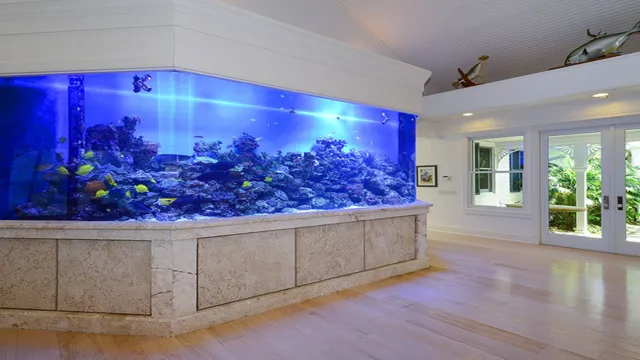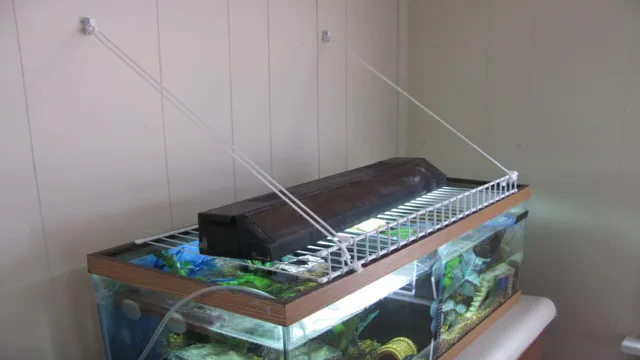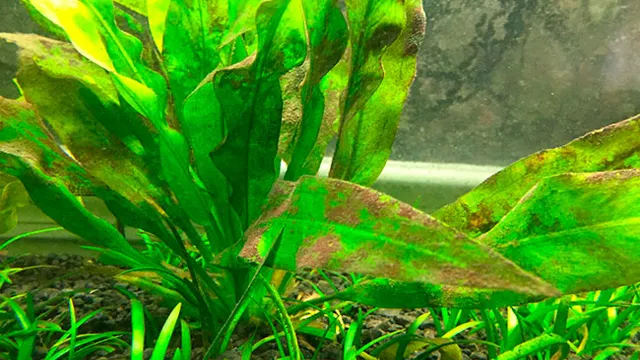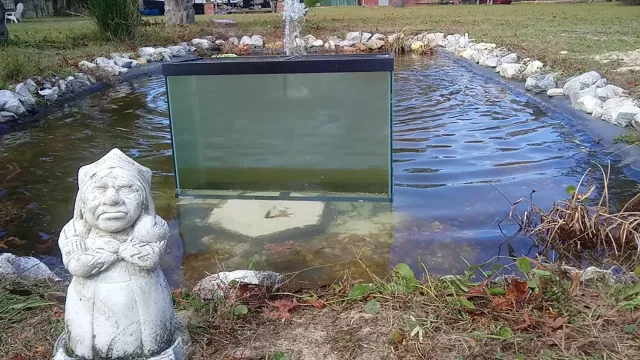If you’re an avid fish enthusiast, you know the importance of providing your aquatic pets with a suitable environment to thrive in. One of the most important aspects of keeping fish is providing them with adequate space, which means investing in a large glass aquarium. While purchasing one might seem like the easier option, creating your own custom-made aquarium can be a rewarding and cost-effective project.
Not only will it give you a sense of pride, but it also gives you the ability to customize the size, shape, and design of your tank. In this blog, we’ll go over the steps required to make a large glass aquarium that will be suitable for all your aquatic critters. So, buckle up, grab a pencil, and let’s dive in!
Materials Needed
If you are looking to make large glass aquariums, you will need a few essential materials. Firstly, you will need high-quality glass panels that are thick and sturdy enough to hold the weight of water and aquatic life. Along with this, you will need specialized silicone sealant that is designed for aquariums.
This sealant is non-toxic and safe for aquatic life and will ensure that the glass panels stick together firmly. You will also need a tape measure, glass cutter, and a level to ensure that your measurements are accurate, and the panels are aligned correctly. Additionally, gloves and a scraper will be required to apply the silicone sealant effectively and protect your hands from the harsh chemicals used in the process.
Finally, you may also want to invest in an aquarium kit that includes items such as filters, heaters, and lighting to make your aquarium look stunning and comfortable for aquatic life. Making large glass aquariums may require some time and effort, but the results are definitely worth it!
Glass sheets
If you are planning on using glass sheets for your project, there are a few materials you will need to make sure you have on hand. Firstly, you will need the glass itself. Depending on your project, you may want to consider tempered glass, which is stronger and more durable than regular glass, or laminated glass, which is made up of multiple layers and is often used for safety reasons.
You will also need a glass cutter, which can be used to cut the glass to the desired size and shape. Additionally, you may want to invest in a glass grinder, which can be used to smooth the edges of the glass after cutting. Finally, be sure to have safety equipment on hand, such as gloves and eye protection, as glass can be dangerous if not handled properly.
By having these materials on hand, you can ensure that your glass sheet project goes smoothly and safely.
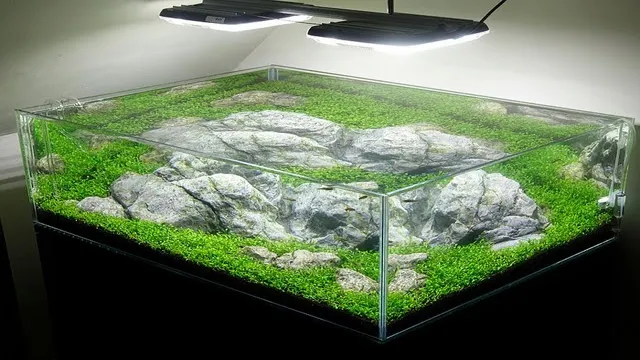
Aquarium silicone sealant
If you’re considering creating or repairing an aquarium, then you may need aquarium silicone sealant. While there are many brands available, there are certain materials that you’ll need to ensure the sealant performs well and bonds properly to the glass. First, you’ll want to have clean and dry surfaces to apply the sealant on.
This means using a glass cleaner or alcohol to remove any dirt or grime. Next, you’ll need a caulking gun to apply the sealant in an even and controlled manner. Finally, make sure to have gloves to protect your skin from any contact with the silicone, which can be irritating.
By having these materials on hand, you’ll be ready to tackle any aquarium project with ease.
Aquarium plastic frame or trim
When it comes to building an aquarium, the materials you choose are crucial to its overall function and appearance. One aspect of an aquarium that often goes overlooked is the plastic frame or trim. This component not only provides a decorative and finished look to the aquarium but it can also add structural support and protect the glass edges from damage.
To create the perfect plastic frame or trim, you’ll need to have a clear plan in place and choose the right materials. First, decide on the size and shape of your aquarium and measure the length and width of each panel. Then, choose a high-quality plastic material that is both durable and resistant to water damage.
Some popular choices include acrylic, PVC, and composite materials. Don’t forget to also consider the color and finish of the plastic, as this can greatly enhance the overall aesthetic of your aquarium. With the right materials and careful planning, you can create a stunning and functional plastic frame or trim for your aquarium that will make it stand out in any room.
Measurements and Design
If you’re looking to make a large glass aquarium, there are a few crucial measurements you’ll need to consider before diving in. First, you’ll need to determine the length, width, and height of the tank to ensure it can accommodate the amount of water and fish you plan to house. Additionally, you’ll want to consider the thickness of the glass, as larger tanks require thicker glass to support the weight of the water.
Once you have these measurements in mind, it’s time to start designing your aquarium. Creating a blueprint or sketch can be helpful in visualizing the final product and making necessary adjustments before construction. When building the tank, it’s important to work with precision to ensure a tight fit and avoid any leaks or cracks.
Overall, making a large glass aquarium requires a combination of careful measurements and design to create a beautiful and functional home for your aquatic pets. (See Also: How to Make Fish Aquarium With Thermocol: Step-by-Step Guide for Beginners)
Calculate volume needed
When it comes to construction projects, a crucial aspect is calculating the volume needed for materials such as concrete, gravel, or sand. Accurate measurements and design plans are necessary for avoiding costly mistakes, such as ordering too little or too much. Firstly, it’s essential to measure the dimensions of the area to be covered or filled.
This can involve determining the length, width, and depth of the space. However, irregularly shaped areas may require more complex calculations. Once you have the measurements, you can use them to calculate the volume of material required.
This involves multiplying the length, width, and depth to find the cubic footage or meters needed. Keep in mind that cubic footage/ meters can be converted to weight, depending on the specific density of the material. By taking the time to measure accurately and make precise calculations, you can save yourself time, money, and frustration in the long run.
Determine dimensions
When you’re designing a new project, determining the dimensions is a crucial step in the process. Before you start cutting any materials, you need to have a clear idea of the size and shape of the finished product. Depending on the project, you may need to consider factors such as weight, strength, and stability.
Take accurate measurements to ensure that your design is both functional and aesthetically pleasing. Use tools such as rulers, tape measures, and level to get precise measurements. You’ll also want to consider any potential limitations, such as available space or budget constraints.
By taking the time to carefully plan out your project, you’ll be able to create something that meets your needs and exceeds your expectations. Remember, the most important thing is to have fun and enjoy the process of creating something new.
Design layout and ensure stability
When it comes to designing layouts, measurements are key. Every design element needs to be measured and placed precisely in order to create a stable and aesthetically pleasing layout. Whether you are designing a website, magazine, or flyer, the measurements and design elements need to work together seamlessly.
One way to achieve this is through the use of grids and guidelines. These tools can help you maintain consistency and balance throughout your design, ensuring that every element fits into place. Additionally, it’s important to consider the stability of your layout.
A stable design will feel balanced and cohesive, while an unstable design will appear chaotic and disorganized. By taking the time to measure and carefully design your layout, you can create a visually appealing and stable design that is sure to catch the eye of your audience. So, the next time you’re designing a layout, don’t forget the importance of measurements and design.
Assembly Process
Creating a large glass aquarium might sound like a daunting task, but with the right tools and approach it can be a fun and rewarding experience. The first step is to gather all the necessary materials, which include glass panes, silicone sealant, a level, and some clamps to hold the pieces in place while the sealant dries. It’s important to measure the dimensions of your tank precisely before purchasing the glass to ensure a perfect fit.
Once you have all the pieces, assemble them in the desired order, applying the sealant carefully between each joint and using the clamps to hold the pieces together. Make sure to smooth out any excess sealant along the joints to ensure a tight seal. Assemble the bottom pane first, and then add the sides, back, and finally the front pane.
Once everything is in place, let the sealant dry for at least 24 hours before filling the tank with water. Congratulations, you’ve just made your very own large glass aquarium! With proper care, it will provide you and your aquatic pets with endless hours of enjoyment.
Clean and prepare glass sheets
When it comes to the assembly process of glass products, one of the most critical steps is cleaning and preparing the glass sheets. Dust, debris, and fingerprints can easily accumulate on the surface of the glass, which can compromise the quality of the final product. To get the best results, it’s essential to use high-quality cleaning supplies specifically designed for glass surfaces.
These include microfiber cloths, non-abrasive glass cleaners, and isopropyl alcohol. Before cleaning, make sure to inspect the glass sheets for any damage or cracks. Any damaged sheets should be discarded as they can weaken the entire structure.
Once the glass is cleaned and prepared, it’s ready for the assembly process. Remember the importance of following safety guidelines to avoid any mishaps and ensure a successful assembly.
Apply silicone sealant and attach glass panels
The assembly process for your glass panels may seem daunting, but it’s actually quite simple with the right tools and instructions. First, ensure that your glass panels fit securely into the designated frame. Apply a silicone sealant around the edges of the panel, making sure to evenly distribute it for a tight seal. (See Also: How to Lower High Nitrate Levels in Freshwater Aquarium: Tips and Techniques)
Once the sealant is applied, carefully press the glass panel into place and hold it steady until the sealant sets. Repeat this process for all of your glass panels. It’s important to pay attention to the type of sealant you use as it should be able to adhere to both glass and the frame material.
Remember to take your time and work in a well-ventilated area to avoid inhaling any fumes. Following these steps will ensure that your glass panels are securely attached to your frame and ready to be enjoyed for years to come.
Secure plastic frame or trim
When it comes to the assembly process of a secure plastic frame or trim, there are a few key steps to keep in mind. First, it’s important to ensure that all the necessary materials and tools are on hand before getting started. This includes the frame or trim pieces themselves, as well as any fasteners, adhesives, or other components that will be needed to hold everything together.
Once everything is ready, the next step is to carefully and accurately measure and cut each piece according to the specifications of the project. This will help ensure a secure and snug fit that will hold up over time. From there, the pieces can be assembled using a variety of methods, including screws, rivets, clips, or adhesives.
Regardless of which method is used, the goal is always the same: to create a finished product that is strong, durable, and able to withstand the test of time. By taking the time to carefully plan and execute each step of the assembly process, it’s possible to create a secure plastic frame or trim that looks great and performs well, no matter what the application may be.
Let it cure and inspect for leaks
After assembling the various components of your project, it’s important to let it cure before inspecting it for leaks. Curing is a crucial process that allows the adhesive to fully harden, ensuring the bond is strong and durable. Depending on the type of adhesive used and the ambient temperature and humidity, curing times can vary.
As a general rule, it’s best to wait at least 24 hours before considering the project cured. Once the curing process is complete, you can begin inspecting for leaks. Make sure to check all joints and connections thoroughly and test the system under pressure to ensure there are no leaks.
This step is critical to avoid any potential damage or accidents that can occur if the system fails due to a leak. Taking the time to properly cure and inspect your project can save you a lot of time, money, and headaches in the long run.
Maintenance and Care Tips
Making a large glass aquarium can be a fun and exciting project for any aquarium enthusiast. The first step is to measure the area where the aquarium will be placed to ensure that it fits comfortably. After that, it’s important to choose the right glass for the aquarium, as thicker glass is required for larger sizes.
Once the glass is cut to size, the edges should be sanded and polished to prevent any sharp edges that could harm fish or humans. The next step is to assemble the glass pieces using an aquarium silicone sealer. It’s important to ensure that the seals are watertight before filling the tank with water.
Once the tank is filled, it’s time to add decorations and plants to create a suitable environment for the fish. Investing in high-quality equipment such as a quality filtration system and regular maintenance will make all the difference. Keeping the tank clean and monitoring chemical levels is critical to the health of the fish.
Regular water changes, testing, and cleaning of the tank will help maintain a thriving aquarium. By following these tips, anyone can create and maintain a large glass aquarium that is both functional and beautiful.
Proper cleaning techniques
When it comes to cleaning your belongings, it’s important to know the proper techniques to ensure they stay looking their best. One important maintenance and care tip is to always read the care instructions for your items before cleaning them. This will ensure that you use the appropriate cleaning products and techniques, and avoid damaging your belongings.
For example, some fabrics require gentle, hand-washing, while others can be safely washed in a machine. Another tip is to avoid using harsh chemicals or bleach-based products, as these can damage or discolor your items. Instead, opt for gentle, non-toxic cleaning products or DIY solutions like vinegar and baking soda.
Finally, be sure to properly dry and store your items after cleaning to avoid mold or mildew growth. By following these proper cleaning techniques, you can ensure that your belongings stay looking their best for years to come.
Regular water changes and testing
Regular water changes and testing are essential in maintaining the overall health and wellbeing of your aquarium inhabitants. These routine maintenance tasks help to remove harmful toxins and ensure the water remains balanced and healthy for your fish and other aquatic life. When it comes to testing the water, it’s important to keep track of parameters such as ammonia, nitrate, and pH levels, which can fluctuate over time and cause stress or even illness for your fish. (See Also: How to Clean Algae from Aquarium Gravel in Five Easy Steps)
Regular water changes can help to dilute any buildup of toxins or excess nutrients in the water, helping to keep the environment clean and safe for your aquatic pets. It’s recommended to change 10-20% of the water each week, depending on the size of your tank and the number of fish living in it. By staying on top of regular water changes and testing, you can help to maintain a healthy and thriving aquarium ecosystem that your fish will love to call home.
Prevent overcrowding and maintain appropriate temperature
When it comes to maintaining the health and welfare of your pets, overcrowding and appropriate temperature are key factors to consider. Overcrowding can quickly lead to stress and disease, especially in smaller, more delicate species. Be sure to research the appropriate tank size and number of occupants for your specific pets.
Additionally, maintaining a consistent temperature is crucial for the health of your pets. Invest in a good quality heater or cooling system to ensure the temperature remains within the recommended range. Regularly cleaning the tank or enclosure and monitoring water quality also plays a vital role in keeping your pets happy and thriving.
Remember, proper care and attention to detail will go a long way in creating a healthy and vibrant habitat for your beloved pets. So, protect them, give them plenty of room to move around, and keep them cozy with a regulated temperature – they’ll thank you for it!
Conclusion
In conclusion, making large glass aquariums is no small feat, but with focus, patience, and the right tools, anyone can create a stunning underwater oasis. Just remember to measure twice, cut once, and never underestimate the power of silicone sealant. And if all else fails, remember that sometimes the best way to make a glass aquarium is to simply buy one already made and let someone else do the hard work.
Either way, happy fishkeeping!”
FAQs
What materials do I need to make a large glass aquarium?
You will need glass panels, silicone sealant, a glass cutter, and a measuring tape.
How thick should the glass be for a large aquarium?
The glass should be at least 1/2 inch thick for a large aquarium to ensure it can hold the weight of the water.
What size should I make a large glass aquarium?
The size of your aquarium depends on the space you have available and the type of fish you plan to keep. As a general rule, plan for a minimum of 10 gallons of water per fish.
Can I make a large glass aquarium without any prior experience?
It is possible to make a large glass aquarium without experience, but it is recommended that you consult a professional or follow detailed instructions to ensure the safety and stability of the aquarium.
How do I ensure that the silicone sealant is strong enough to hold the glass panels together?
To ensure a strong bond, make sure the glass panels are clean and free of debris before applying the silicone sealant. Use a silicone sealant that is specifically formulated for aquariums and allow it to cure for at least 48 hours before adding water.
Can I add decorations to a large glass aquarium?
Yes, you can add decorations to a large glass aquarium, but make sure they are aquarium-safe and do not contain any substances that may harm the fish.
How do I maintain a large glass aquarium?
Regular maintenance includes changing the water regularly, testing the water quality, cleaning the aquarium walls, and ensuring the equipment is functioning properly. It is also important to monitor the health of the fish and address any issues promptly.

